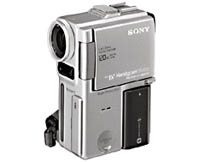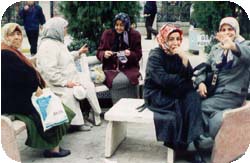I Love AV


 One of my favourite depictions of people mastering their lives by mastering the act of image-making is the Talking Heads song 'Found A Job'. Bob and Judy are a couple who watch TV passively, complain about the picture, grouse that nothing's ever on. Then one day they decide to make their own. They set about 'inventing situations, putting them on TV'. It's a wild success (presumably on one of the wonderful public access cable stations here in New York, where anybody can show anything) and their lives are transformed. The song goes into an industrious and upbeat melody which builds then fades, suggesting Bob and Judy happily occupied forever now, replacing the meaningless images which oppressed and bored them with meaningful images of their own.
One of my favourite depictions of people mastering their lives by mastering the act of image-making is the Talking Heads song 'Found A Job'. Bob and Judy are a couple who watch TV passively, complain about the picture, grouse that nothing's ever on. Then one day they decide to make their own. They set about 'inventing situations, putting them on TV'. It's a wild success (presumably on one of the wonderful public access cable stations here in New York, where anybody can show anything) and their lives are transformed. The song goes into an industrious and upbeat melody which builds then fades, suggesting Bob and Judy happily occupied forever now, replacing the meaningless images which oppressed and bored them with meaningful images of their own. There's something paradoxical about AV equipment, especially still cameras, video cameras and projectors. It seems to be the epitome of capitalist high tech. A single lens reflex camera is cold, metallic, glossy. It suggests a schizoid detachment from the world and from humanity. Films about photographers usually portray them as murderers (Peeping Tom) or witnesses to murder (Blow Up).
There's something paradoxical about AV equipment, especially still cameras, video cameras and projectors. It seems to be the epitome of capitalist high tech. A single lens reflex camera is cold, metallic, glossy. It suggests a schizoid detachment from the world and from humanity. Films about photographers usually portray them as murderers (Peeping Tom) or witnesses to murder (Blow Up). Put AV in the hands of Aquarians (you know, the people of The Epoch, humane in principle, somewhat cooler in practice) and its tendency to make us detached is no longer something schizoid and zonked-out, a symbol of how we've become commodified and zombified. Instead it lines up with the utopian otherworldliness of political radicalism. It's all about finding flaws in capitalism, looking inwards, looking onwards and upwards. Looking for an elsewhere, an Other, a next thing. And so, in the hands of a principled, confused, experimental person the capitalist AV machine -- the single lens reflex camera, the video camera -- can be turned against capitalism. It becomes a tool of reflection and reflexivity and an example of how capitalism's most sophisticated products, rather than bolstering the system, can actually undermine it. Capitalism manufactures freedom machines. We look through them and see new ways we might live.
Put AV in the hands of Aquarians (you know, the people of The Epoch, humane in principle, somewhat cooler in practice) and its tendency to make us detached is no longer something schizoid and zonked-out, a symbol of how we've become commodified and zombified. Instead it lines up with the utopian otherworldliness of political radicalism. It's all about finding flaws in capitalism, looking inwards, looking onwards and upwards. Looking for an elsewhere, an Other, a next thing. And so, in the hands of a principled, confused, experimental person the capitalist AV machine -- the single lens reflex camera, the video camera -- can be turned against capitalism. It becomes a tool of reflection and reflexivity and an example of how capitalism's most sophisticated products, rather than bolstering the system, can actually undermine it. Capitalism manufactures freedom machines. We look through them and see new ways we might live. When I've sung about AV equipment in my songs I've usually expressed this tension between the cold equipment itself and the more hot-blooded uses it's put to when it enters the service of sex and revolution. Cameras tell scalding hot truths, whether about the naked human body or the naked brutality of power. Sometimes, nothing is more passionate than a documentary.
When I've sung about AV equipment in my songs I've usually expressed this tension between the cold equipment itself and the more hot-blooded uses it's put to when it enters the service of sex and revolution. Cameras tell scalding hot truths, whether about the naked human body or the naked brutality of power. Sometimes, nothing is more passionate than a documentary. Being a bit of a 'recording angel', I've always been fascinated by AV equipment. I've wanted to put my whole life on tape, as though this mechanical self-consciousness were the route to divine wisdom, or as though having an archive of seminal events (including semenal events) brought us closer to the non-linear experience of life I've called random access.
Being a bit of a 'recording angel', I've always been fascinated by AV equipment. I've wanted to put my whole life on tape, as though this mechanical self-consciousness were the route to divine wisdom, or as though having an archive of seminal events (including semenal events) brought us closer to the non-linear experience of life I've called random access. photographed the American bicentennial celebrations in upstate New York (re-enactments of battles in which revolutionary upstarts trounced the British). Soon I switched to SLRs. I had an East German Practika L (with a separate Russian light meter) in Edinburgh in the late 70s. I was into Polish-style photography -- alienated black and white grainy wide angle shots won me the school photography prize. There were no white horses, decrepit schoolrooms or heavily mascaraed naked Polish beauties in Edinburgh at the time, so I made do with angsty snaps of my sister throwing histrionic shapes against the sky in Drummond Place Gardens. I developed and printed at home. The red light, the faintly urinous smell of developer and fixer -- these will forever be the flavour of 1977.
photographed the American bicentennial celebrations in upstate New York (re-enactments of battles in which revolutionary upstarts trounced the British). Soon I switched to SLRs. I had an East German Practika L (with a separate Russian light meter) in Edinburgh in the late 70s. I was into Polish-style photography -- alienated black and white grainy wide angle shots won me the school photography prize. There were no white horses, decrepit schoolrooms or heavily mascaraed naked Polish beauties in Edinburgh at the time, so I made do with angsty snaps of my sister throwing histrionic shapes against the sky in Drummond Place Gardens. I developed and printed at home. The red light, the faintly urinous smell of developer and fixer -- these will forever be the flavour of 1977. After that it was Polaroids and camcorders, the only way I dared document my (perfectly normal) love life in a Britain in which, to this day, Boots the Chemist regularily hands pictures of naked children (usually taken by proud parents) to the police and PC World passes the 'pseudo photographs' on your broken hard disk to the Vice Squad.
After that it was Polaroids and camcorders, the only way I dared document my (perfectly normal) love life in a Britain in which, to this day, Boots the Chemist regularily hands pictures of naked children (usually taken by proud parents) to the police and PC World passes the 'pseudo photographs' on your broken hard disk to the Vice Squad. My loss of 3D vision due to a contact lens fuck up coincided with the arrival of digital photography. Something about the world going suddenly flat made me look at everything more graphically, more formally, and more passionately. Now I take my battered, Cutie-stickered Fujifilm MX 700 with me wherever I go. Friends are used to a two-minute wait while I pause to photograph something. It's really eroticised my relationship with the street.
My loss of 3D vision due to a contact lens fuck up coincided with the arrival of digital photography. Something about the world going suddenly flat made me look at everything more graphically, more formally, and more passionately. Now I take my battered, Cutie-stickered Fujifilm MX 700 with me wherever I go. Friends are used to a two-minute wait while I pause to photograph something. It's really eroticised my relationship with the street.  Because my father ran a language college and used AV equipment in teaching, we had a video camera in the 70s long before most families. I remember recording onto big clunky Betamax tapes. I bought an American paperback with groovy bloopy lettering called 'The Video Handbook'. It sat on my shelf next to a book about biorhythms. It was about how you should make community tapes and circulate them amongst friends.
Because my father ran a language college and used AV equipment in teaching, we had a video camera in the 70s long before most families. I remember recording onto big clunky Betamax tapes. I bought an American paperback with groovy bloopy lettering called 'The Video Handbook'. It sat on my shelf next to a book about biorhythms. It was about how you should make community tapes and circulate them amongst friends.  One of my greatest pleasures is browsing in the trendy Japanese store Zakka on Grand Street. There you can see sexy, totally textless photobooks (they're called shashin-shu in Japanese) by all the post-Hiromix Japanese girl photographers, or people like Takashi Homma and Hibiki Tokiwa. I also get sent a lot of pictures as e mail attachments by Japanese fans, who all have digital cameras and use them to photograph the shadows of twigs, a naked leg, a spiky fruit, the sky, a phone booth with a pink phone, a manga, a cat, some lettering. Japanese girls love photography. Kahimi Karie began as a rock photographer (she photographed Gainsbourg when he came to Japan, and even got him to take off his dark glasses). When my friend Riho Aihara had her portfolio published in the New Creators 2000 issue of Tokion magazine my heart swelled with pride.
One of my greatest pleasures is browsing in the trendy Japanese store Zakka on Grand Street. There you can see sexy, totally textless photobooks (they're called shashin-shu in Japanese) by all the post-Hiromix Japanese girl photographers, or people like Takashi Homma and Hibiki Tokiwa. I also get sent a lot of pictures as e mail attachments by Japanese fans, who all have digital cameras and use them to photograph the shadows of twigs, a naked leg, a spiky fruit, the sky, a phone booth with a pink phone, a manga, a cat, some lettering. Japanese girls love photography. Kahimi Karie began as a rock photographer (she photographed Gainsbourg when he came to Japan, and even got him to take off his dark glasses). When my friend Riho Aihara had her portfolio published in the New Creators 2000 issue of Tokion magazine my heart swelled with pride.